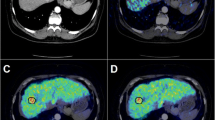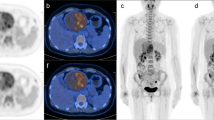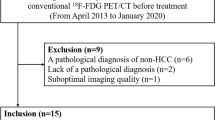Abstract
Liver tumors, especially hepatocellular carcinomas (HCCs), often exhibit no contrast with surrounding non-tumorous liver tissue in F-18-fluoro-2-deoxy-2-fluoro-d-glucose (FDG) positron emission tomography (PET) images obtained at the usual interval of one hour after intravenous FDG injection. We evaluated the usefulness of FDG PET studies of liver tumors performed 2 hours after intravenous injection.Methods and Materials: Fifteen pretherapeutic patients with 33 liver tumors were studied, including 11 patients with 18 HCCs, and 4 patients with 15 metastatic liver tumors (METAs) from 3 colorectal carcinomas and 1 esophageal carcinoma. After transmission scans, emission scans were obtained 45–55 minutes and 115–125 minutes after intravenous injection of 185–370 MBq FDG as early images and delayed FDG PET images, respectively. Visual analysis of early and delayed images was performed, and the FDG uptake in the tumor to that in nontumorous liver ratio (T/N ratio), the FDG uptake in tumor to that in soft-tissue ratio (T/S ratio) and the FDG uptake in non-tumorous liver to that in soft-tissue ratio (N/S ratio) were calculated for each image.Results: In visual analysis, visual improvement seen in images was observed in 6 of 18 HCC lesions and all 15 META lesions. In quantitative analysis, the mean T/S ratio and T/N ratio of HCCs in early images were 4.97 and 1.90, respectively, and those in delayed images were 6.24 and 2.20, respectively. The mean T/S ratio and T/N ratio of METAs in early images were 5.97 and 2.21, respectively, and those in delayed images were 6.99 and 3.80, respectively. The T/S ratio of HCCs and T/S ratio and T/N ratio of METAs were significantly higher in delayed images than in early images. The mean N/S ratios of HCC cases were 2.58 in the early images and 2.57 in the delayed images, but the ratio showed no constant tendency in the images. All N/S ratios of META cases were decreased in delayed images, although the significance of the small number of cases.Conclusion: FDG PET studies performed 2 hours after intravenous injection were useful for clear visualization of liver tumors, especially metastatic liver tumors.
Similar content being viewed by others
References
Strauss LG, Conti PS. The applications of PET in clinical oncology.J Nucl Med 1991; 32: 623–648; discussion 649–650.
Choi JY, Kim SE, Shin HJ, Kim BT, Kim JH. Brain tumor imaging with99mTc-tetrofosmin: comparison with201Tl,99mTc-MIBI, and18F-fluorodeoxyglucose.J Neurooncol 2000; 46: 63–70.
Sazon DA, Santiago SM, Soo Hoo GW, Khonsary A, Brown C, Mandelkern M, et al. Fluorodeoxyglucosepositron emission tomography in the detection and staging of lung cancer.Am J Respir Crit Care Med 1996; 153: 417–421.
Keogan MT, Tyler D, Clark L, Branch MS, McDermott VG, DeLong DM, et al. Diagnosis of pancreatic carcinoma: role of FDG PET.Am J Roentgenol 1998; 171: 1565–1570.
Sugawara Y, Eisbruch A, Kosuda S, Recker BE, Kison PV, Wahl RL. Evaluation of FDG PET in patients with cervical cancer.J Nucl Med 1999; 40: 1125–1131.
Okazumi S, Isono K, Enomoto K, Kikuchi T, Ozaki M, Yamamoto H, et al. Evaluation of liver tumors using fluorine-18-fluorodeoxyglucose PET: characterization of tumor and assessment of effect of treatment [see comments].J Nucl Med 1992; 33: 333–339.
Torizuka T, Tamaki N, Inokuma T, Magata Y, Sasayama S, Yonekura Y, et al.In vivo assessment of glucose metabolism in hepatocellular carcinoma with FDG-PET.J Nucl Med 1995; 36: 1811–1817.
Ogunbiyi OA, Flanagan FL, Dehdashti F, Siegel BA, Trask DD, Birnbaum EH, et al. Detection of recurrent and metastatic colorectal cancer: comparison of positron emission tomography and computed tomography [see comments].Ann Surg Oncol 1997; 4: 613–620.
Messa C, Choi Y, Hoh CK, Jacobs EL, Glaspy JA, Pege S, et al. Quantification of glucose utilization in liver metastases: parametric imaging of FDG uptake with PET.J Comput Assist Tomogr 1992; 16: 684–689.
Lai DT, Fulham M, Stephen MS, Chu KM, Solomon M, Thompson JF, et al. The role of whole-body positron emission tomography with [18F]fluorodeoxyglucose in identifying operable colorectal cancer metastases to the liver.Arch Surg 1996; 131: 703–707.
Di Chiro G. Positron emission tomography using [18F] fluorodeoxyglucose in brain tumors: a powerful diagnostic and prognostic tool.Invest Radiol 1987; 22: 360–371.
Bida GT, Satyamurthy N, Barrio JR. The synthesis of 2-[F-18]fluoro-2-deoxy-d-glucose using glycals: a reexamination.J Nucl Med 1984; 25: 1327–1334.
Delbeke D, Martin WH, Sandler MP, Chapman WC, Wright JK Jr, Pinson CW. Evaluation of benign vs. malignant hepatic lesions with positron emission tomography.Arch Surg 1998; 133: 510–515; discussion 515–516.
Torizuka T, Tamaki N, Inokuma T, Magata Y, Yonekura Y, Tanaka A, et al. Value of fluorine-18-FDG-PET to monitor hepatocellular carcinoma after interventional therapy.J Nucl Med 1994; 35: 1965–1969.
Findlay M, Young H, Cunningham D, Iveson A, Cronin B, Hickish T, et al. Noninvasive monitoring of tumor metabolism using fluorodeoxyglucose and positron emission tomography in colorectal cancer liver metastases: correlation with tumor response to fluorouracil [see comments].J Clin Oncol 1996; 14: 700–708.
Enomoto K, Okazumi S, Fukunaga T, Asano T, Kikuchi T, Nagashima T, et al. The efficacy of18F-fluorodeoxyglucose positron emission tomography for the evaluation of hepato-cellular carcinoma treatment (in Japanese).Kanzo 1993; 34: 464–470.
Okazumi S, Enomoto K, Ozaki M, Yamamoto H, Yoshida M, Abe Y, et al. Evaluation of the effect of treatment for patients with liver tumors using18F-fluorodeoxyglucose PET (in Japanese).KAKU IGAKU (Jpn J Nucl Med) 1989; 26: 793–797.
Knox WE, Jamdar SC, Davis PA. Hexokinase, differentiation and growth rates of transplanted rat tumors.Cancer Res 1970; 30: 2240–2244.
Imdahl A, Nitzsche E, Krautmann F, Hogerle S, Boos S, Einert A, et al. Evaluation of positron emission tomography with 2-[18F]fluoro-2-deoxy-d-glucose for the differentiation of chronic pancreatitis and pancreatic cancer.Br J Surg 1999; 86: 194–199.
Kubota K, Itoh M, Ozaki K, Ono S, Tashiro M, Yamaguchi K, et al. Advantage of delayed whole-body FDG-PET imaging for tumour detection.Eur J Nucl Med 2001; 28: 696–703.
Gallagher BM, Fowler JS, Gutterson NI, MacGregor RR, Wan CN, Wolf AP. Metabolic trapping as a principle of radiopharmaceutical design: some factors responsible for the biodistribution of [18F] 2-deoxy-2-fluoro-d-glucose.J Nucl Med 19: 1154–1161, 1978.
Fukuda H. Diagnosis of liver tumors with18F-FDG and18F-FDGal using PET (in Japanese).Nippon Rinsho 1991; 49: 1863–1867.
Cremerius U, Fabry U, Neuerburg J, Zimny M, Osieka R, Buell U. Positron emission tomography with18F-FDG to detect residual disease after therapy for malignant lymphoma.Nucl Med Commun 1998; 19: 1055–1063.
Zimny M, Bares R, Fass J, Adam G, Cremerius U, Dohmen B, et al. Fluorine-18 fluorodeoxyglucose positron emission tomography in the differential diagnosis of pancreatic carcinoma: a report of 106 cases.Eur J Nucl Med 1997; 24: 678–682.
Peterson MS, Baron RL. Radiologic diagnosis of hepato-cellular carcinoma.Clin Liver Dis 2001; 5: 123–144.
Author information
Authors and Affiliations
Corresponding author
Rights and permissions
About this article
Cite this article
Koyama, K., Okamura, T., Kawabe, J. et al. The usefulness of18F-FDG PET images obtained 2 hours after intravenous injection in liver tumor. Ann Nucl Med 16, 169–176 (2002). https://doi.org/10.1007/BF02996297
Received:
Accepted:
Issue Date:
DOI: https://doi.org/10.1007/BF02996297




